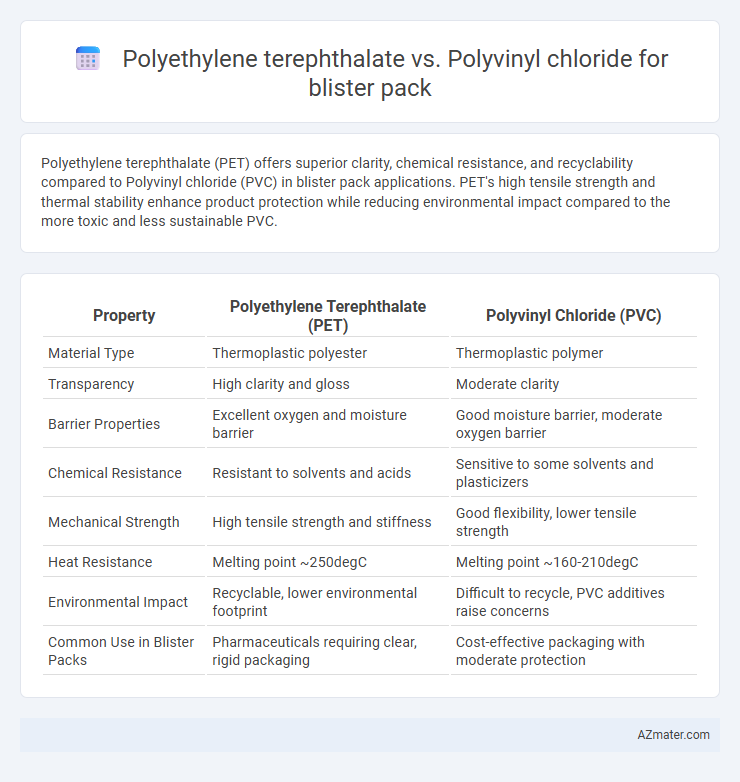Polyethylene terephthalate (PET) offers superior clarity, chemical resistance, and recyclability compared to Polyvinyl chloride (PVC) in blister pack applications. PET's high tensile strength and thermal stability enhance product protection while reducing environmental impact compared to the more toxic and less sustainable PVC.
Table of Comparison
| Property | Polyethylene Terephthalate (PET) | Polyvinyl Chloride (PVC) |
|---|---|---|
| Material Type | Thermoplastic polyester | Thermoplastic polymer |
| Transparency | High clarity and gloss | Moderate clarity |
| Barrier Properties | Excellent oxygen and moisture barrier | Good moisture barrier, moderate oxygen barrier |
| Chemical Resistance | Resistant to solvents and acids | Sensitive to some solvents and plasticizers |
| Mechanical Strength | High tensile strength and stiffness | Good flexibility, lower tensile strength |
| Heat Resistance | Melting point ~250degC | Melting point ~160-210degC |
| Environmental Impact | Recyclable, lower environmental footprint | Difficult to recycle, PVC additives raise concerns |
| Common Use in Blister Packs | Pharmaceuticals requiring clear, rigid packaging | Cost-effective packaging with moderate protection |
Introduction to Blister Pack Materials
Polyethylene terephthalate (PET) and Polyvinyl chloride (PVC) are widely used materials in blister packaging due to their distinct properties. PET offers superior clarity, chemical resistance, and recyclability, making it ideal for high-quality product visibility and environmental sustainability. PVC provides excellent durability and flexibility, often preferred for its cost-effectiveness and ease of forming into complex shapes for secure product protection.
Overview of Polyethylene Terephthalate (PET)
Polyethylene terephthalate (PET) is a widely used thermoplastic polymer known for its excellent clarity, strength, and barrier properties, making it ideal for blister pack applications. PET offers superior resistance to moisture, oxygen, and chemicals compared to polyvinyl chloride (PVC), ensuring better product protection and shelf life. Its recyclability and lightweight nature contribute to sustainable packaging solutions while maintaining durability and consumer safety.
Overview of Polyvinyl Chloride (PVC)
Polyvinyl chloride (PVC) is a widely used polymer in blister pack manufacturing due to its excellent clarity, toughness, and cost-effectiveness. PVC provides good barrier properties against moisture and gases, aiding in the preservation of pharmaceutical products. However, its chemical resistance and environmental impact are less favorable compared to polyethylene terephthalate (PET), influencing material choice based on application needs.
Mechanical Strength: PET vs PVC
Polyethylene terephthalate (PET) exhibits higher tensile strength and better impact resistance compared to polyvinyl chloride (PVC), making it more suitable for blister packs requiring enhanced mechanical durability. PET's superior rigidity and resistance to deformation under stress ensure reliable protection for delicate contents while maintaining clarity. In contrast, PVC offers moderate mechanical strength but is more prone to cracking and warping under mechanical loads, limiting its effectiveness in applications demanding robust structural integrity.
Barrier Properties: Moisture and Gas Protection
Polyethylene terephthalate (PET) offers superior moisture barrier properties compared to polyvinyl chloride (PVC), making it highly effective in protecting blister-packed pharmaceuticals from humidity-induced degradation. PET also demonstrates enhanced gas barrier performance, particularly against oxygen, which helps extend product shelf life by preventing oxidation. In contrast, PVC has relatively lower resistance to moisture and gas permeation, limiting its effectiveness for sensitive drug formulations requiring stringent barrier protection.
Clarity and Aesthetics in Packaging
Polyethylene terephthalate (PET) offers superior clarity and gloss compared to polyvinyl chloride (PVC), enhancing product visibility and consumer appeal in blister pack applications. PET's high transparency and smooth surface contribute to a premium aesthetic, while PVC tends to exhibit a slightly yellowish tint that can dull product presentation. The excellent optical properties of PET make it the preferred choice for blister packaging where visual attractiveness and product showcase are critical.
Environmental Impact and Sustainability
Polyethylene terephthalate (PET) is widely favored over polyvinyl chloride (PVC) for blister packs due to its superior recyclability and lower environmental toxicity during disposal. PET's production generates fewer greenhouse gas emissions and avoids chlorine compounds, which are associated with PVC's incineration hazards and persistent environmental pollutants. Sustainability assessments highlight PET's role in circular economy models through effective recycling streams, contrasting with PVC's challenges in both waste management and long-term ecological harm.
Cost Comparison: PET vs PVC
Polyethylene terephthalate (PET) blister packs typically cost more upfront compared to polyvinyl chloride (PVC) due to higher raw material and processing expenses. However, PET's superior durability and recyclability often reduce long-term costs related to waste management and product protection. In contrast, PVC offers lower initial costs but may incur additional expenses from environmental disposal regulations and lower barrier properties.
Regulatory and Safety Considerations
Polyethylene terephthalate (PET) is favored over polyvinyl chloride (PVC) in blister pack applications due to its superior regulatory approval and safety profile, being classified as food contact safe by FDA and EFSA standards. PVC contains potentially harmful additives like phthalates and may release toxic byproducts during incineration, raising environmental and health concerns. PET's excellent chemical resistance, recyclability, and compliance with stringent global safety regulations make it the preferred choice for pharmaceutical and food blister packaging.
Choosing the Right Material for Blister Packs
Polyethylene terephthalate (PET) offers superior clarity, chemical resistance, and recyclability compared to Polyvinyl chloride (PVC), making it an ideal choice for blister packs requiring product visibility and environmental considerations. PVC provides excellent moisture barrier properties and flexibility, suitable for pharmaceutical blister packs that demand strong protection against contaminants. Selecting PET or PVC depends on balancing factors like durability, environmental impact, chemical resistance, and cost-effectiveness in blister pack applications.

Infographic: Polyethylene terephthalate vs Polyvinyl chloride for Blister Pack
 azmater.com
azmater.com